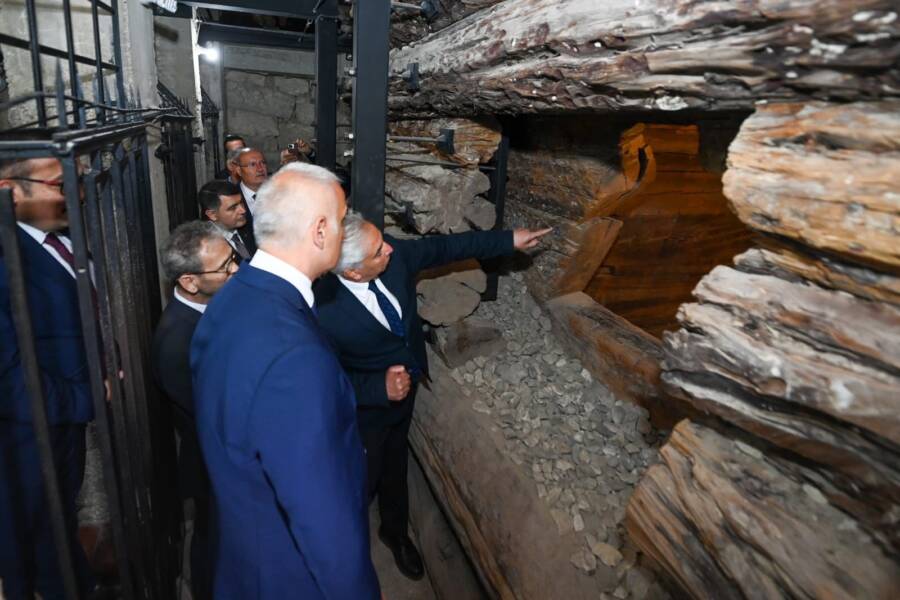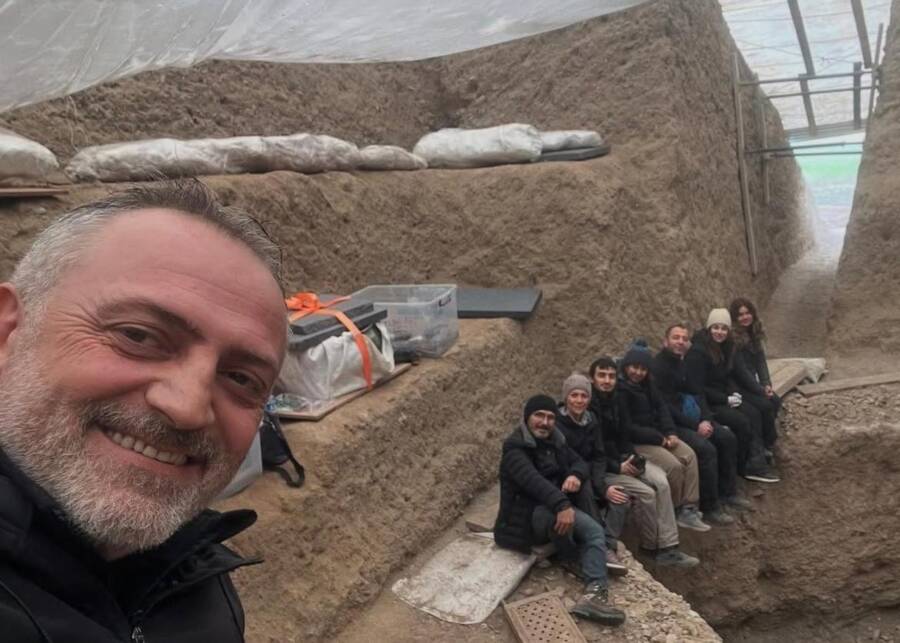Archaeologists excavating at the ruins of Gordion just found an ancient Phrygian tomb that might belong to a relative of the legendary King Midas, the ruler who was said to turn everything he touched into gold.

Mehmet Nuri Ersoy/XOfficials view the newly-uncovered wooden tomb, which archaeologists suspect may belong to a member of King Midas’ family.
Most people know the legend of King Midas, the ancient ruler so greedy that he wished he could turn anything into gold just by touching it. But Midas was likely based on a real-life ruler, King Midas of Phrygia, who lived in present-day Turkey in the 8th century B.C.E. Now, archaeologists have found a tomb that may belong to a member of his family.
During excavations in the ancient city of Gordion — which has its own connection to another famous Greek legend — archaeologists unearthed a wooden burial chamber full of grave goods that dates back to the 8th century B.C.E. They suspect that the tomb has links to the Phrygian royal family and perhaps Midas himself.
The Phrygian Tomb Unearthed In The Ancient City Of Gordion
According to Türkiye Today, archaeologists from Ankara Haci Bayram Veli University discovered the wooden tomb during excavations between September 2024 and January 2025 in the ancient city of Gordion, which is located in Yassıhüyük.

@atakanakcayyy/InstagramArchaeologists excavating Tumulus T26 in the ancient city of Gordion.
The tomb was found inside a tumulus (a burial mound made of earth and stone) at the site, dubbed Tumulus T26. Though the wooden burial chamber had been crushed over the millennia, archaeologists discovered human remains and dozens of grave goods inside, including a 2,700-year-old bronze jug covered with linen.
Archaeologists believe that the tomb dates back to the 8th century B.C.E. Its age, elaborate nature, and plethora of high-quality artifacts suggest that it once belonged to an elite, perhaps a member of the Phrygian royal family.
“During the excavations in the ancient city of Gordion, we unearthed an untouched wooden burial chamber that is thought to belong to the Phrygian royal family,” Culture and Tourism Minister Mehmet Nuri Ersoy said in a statement on X. “The 88 metal artifacts found in the T26 tumulus, most of which are in good condition… provide unique clues about the burial traditions and social structure of the Phrygians.”

Archaeologist1950/Wikimedia CommonsTumuli in Gordion. Tumulus T26 is the 47th registered tumulus at the site.
What’s more, the tomb bears some resemblance to the Midas Tumulus, where archaeologists believe King Midas of Phrygia’s father was buried. That suggests that this tomb also has a link to the ancient king.
“This could very well be a relative of Midas,” Charles Brian Rose, the director of the Gordion excavation, remarked. “This is the only known cremation tomb from the 8th century B.C. in Gordion. Its vessels closely resemble those from the Midas Mound, which makes the connection plausible.”
The Real-Life King Midas: The Man Behind The Myth
The real-life King Midas lived during the 8th century B.C.E. in the ancient kingdom of Phrygia. Little is known about him, though ancient sources suggest that he was extremely wealthy. The Greek historian Herodotus wrote, for instance, that Midas once gifted an elaborate golden throne to the Oracle of Delphi.
Tales of his great wealth possibly inspired a myth about a figure also named King Midas. In this myth, Midas is greedy and, when the Greek god Dionysus offers to grant him a wish, Midas asks for the power to turn anything into gold. The king’s wish then backfired as he could no longer pick flowers, eat food, or drink wine. After turning his daughter into a gold statue, Midas washes his hands in the Pactolus River to rid himself of his power.

Public DomainA depiction of King Midas and his daughter, who he turned to gold.
King Midas wasn’t the only member of his family tied to Greek myth, however. His father Gordias also played a key role in the myth of the Gordian knot. In this myth, Gordias tied a complex knot and claimed whoever could untie it would become king of Asia. When Alexander the Great arrived in Gordion in 333 B.C., he sliced through the knot with his sword.
Though Alexander claimed that the end result was more important than the method, myth suggests that his decision to cut the knot instead of untying it led to his mysterious death at the age of just 32.
After reading about the ancient tomb in Turkey that may have a connection to the real-life King Midas, discover the story of Göbekli Tepe, the Neolithic site in Turkey that might be the oldest temple in the world. Then, learn about the Seven Wonders of the Ancient World.







